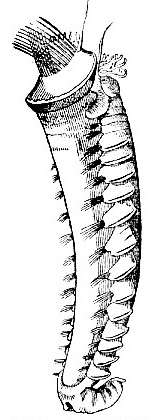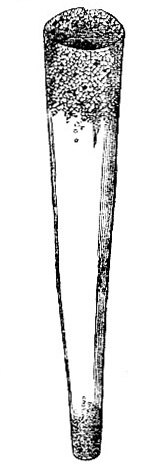1902 Encyclopedia > Annelida > I. Annelida Polychaeta (cont'd): Nervous System. Reproductive System. Replacement of Lost Parts. Tubes.
Annelida
(Part 4)
I. Annelida Polychaeta (cont'd)
Nervous System. Reproductive System. Replacement of Lost Parts. Tubes.
The nervous system has the form of a pair of cephalic ganglia, and a chain of ganglia placed along the ventral aspect of the body (n, fig. 4). The former lie over the oesophagus, and send branches to the eyes, tentacles, and other organs. A cord (buccal) joins them on each side to the ventral chain, and thus the oesophagus is encircled by a nervous collar. In each segment the ventral ganglia give out branches for the supply of the neighbouring organs and feet. The nerve-cells chiefly occur on the ventral surface and sides of the ganglia. In some (e.g., terebella), while the nerve cords are united in the anterior region, they are separate posteriorly. The eyes are much developed in Alciope, certain Syllidae, and others; but, on the other hand, many are eyeless. Most of the eyes are mere masses of black pigment (sometimes capsulated) situated on the head, destitute of means of accommodation, with certain nerve-threads going to them. In Alciope, sclerotic, lens, retina, and other parts exist. In Branchiomma the eyes occupy the branchieae, and in Fabricia the posterior end of the body. Otolithes are stated to be present in a few (e.g. Arenicola), but on these and other minute points further investigation is required. The sense of touch is extremely delicate in the group; on the surface at large, as well as in the tentacles and cirriform processes. Evarne, Nepthys, Ophiodromus, and others, exhibit remarkable irritability.

Fig. 8 -- Parent stock of Autolytus cornutus. (After A. Agassiz.)
The Polychaeta are for the most part dioecious, the sexual glands being variously developed on the inner surface of the body-wall or on the dissepiments, and developing in the forms of ruffs round the vascular axes. The products are detached into the perivisceral cavity. The ciliated and looped segmental organs of Dr. Williams occur very generally, and may conduct towards the sexual elements, but they have also been supposed to be excrementitious. In Tomopteris their ciliary current carries spermatozoa inwards, and the same may occur in other forms. The structure and deposition of the egg, and the changes in its development, agree with those in other classes. Certain Eunicidae are ovo-viviparous. Occasionally the ova are borne on the back (Polynoe), or in a ventral pouch (Autolytus cornutus), until hatched, while in Spirotbis a modification of the operculum acts as an ovisac. The young escape as ciliated organisms with a long whip anteriorly; but, as development progresses, the cilia are confined to certain zones. A few immature forms, again, such as the young of Nerine, carry remarkable bristles, which areshed before the adult form is reached. Some have arranged the larval forms according to the zones of cilia and the temporary bristles. In the growth of the young animal the development of the new segments takes place between the first and last. In certain Nereidae, e.g. Nereis Dumerilii, at least two sexual forms exist, - viz., a small adult which develops either ova or spermatozoa in the usual way (except that in the male the elements occur in two testicles placed in one segment); and, secondly, another which becomes transformed into a Heteronereis before the sexual elements are developed. Metschnikoff has further found another Nereis which is hermaphrodite. The phenomena of alternate generations is also observed in Autolytus, and fissiparity in Filigrana, - the latter, with Spirorbis and Amphiglena, being also hermaphrodite. The female Autolytus quite differs from the male, and has its body loaded with ova, which pass into a pouch in A. cornutus, Agass., and the products by-and-by get exist as free-swimming embryos. The male is wide in front, and has large tentacles, the spermsacs occupying the first five bristled segments. From the young of the foregoing is developed -- so as to complete the series -- the third kind, viz., the "parent-stock: of A. Agassiz, which differs from both the previous forms. No sexual elements occur in the parent-stock, but the males and females are produced from the body by transverse fission (fig. 8).

Fig. 9 -- Clymens amphistoma, Sav., with a fragment of tube on the right. (After Savigny.)
Regeneration of mutilated parts is common in the Polychaeta, even to reproduction of a head.

Fig. 10 -- Hyalinaecia tubicola, O. F. Müller, and tube
The tubes formed by many exhibit an amount of precision and skill not far removed from the powers of the most ingenious insects. In common with the Nemerteans, their skin exudes a tenacious secretion which coheres under water, and this alone forms the protective tube in some; while in others it is strengthened with mud (fig. 9), sand, gravel, shells, and stones. The secretion varies from the most delicate film in the Syllidae, to the tough parchment-tubes of Choetopterus, or the rigid crow-quills of Hyalinoecia (fig. 10).

Fig. 11 -- Pectinaria belgica, Pall. (After Malmgren.)
The eyeless Pectinaria belgica (fig. 11), again, fashions a tube like a straight horn (fig. 12) of minute pebbles or large grains of sand, carefully selected and admirably fixed to each other by a whitish secretion. In placing the grains together in the wall there is no haphazard, but angle fits angle as in a skillfully built wall.

Fig. 12 -- Tube of Fig. 11, partially shaded
Beautiful semi-transparent tubes are constructed by an allied species in the deep sea from the siliceous spicules of sponges. The remarkable arborescent or pectinate processes which ornament the free ends of the tubes of certain terebelloe are also noteworthy. The calcareous tubes of the fixed Serpulidae, or the free (e.g. Ditrypa), differ from those of the molluscs in the absence of organic connection between the animal and its protective sheath. Lastly, large coherent masses of coarsegravel and sand-tubes are formed on various beaches by Sabellaria.
Read the rest of this article:
Annelida - Table of Contents
|




